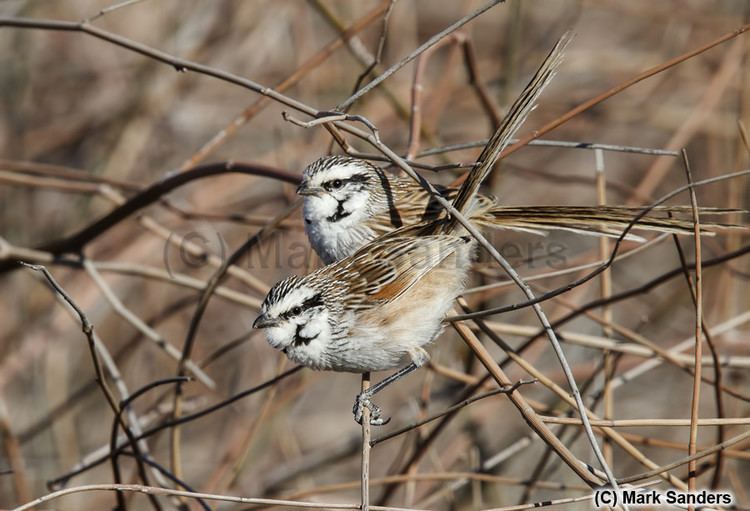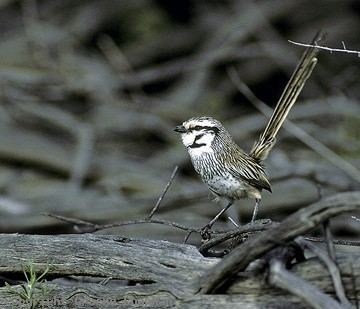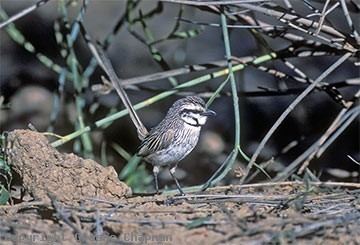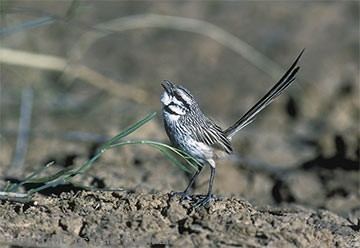Genus Amytornis Phylum Chordata Rank Species | Family Maluridae Scientific name Amytornis barbatus Higher classification Amytornis Order Passerine | |
 | ||
Similar Eyrean grasswren, Amytornis, Striated grasswren, Dusky grasswren, Short‑tailed grasswren | ||
The grey grasswren (Amytornis barbatus) is a passerine bird of the family Maluridae native to inland Australia. It is a rarely seen elusive bird that was first sighted in 1921 but not taxonomically described until 1968. This bird belongs to the Family Maluridae which comprises five genera of passerine birds that are only found in Australia and New Guinea. There are two assemblages, Amytorniae which comprise one genus (Amytornis) and eight species, one of which belongs to the grey grasswren. The second assemblage (Malurinae) contains 4 genera and 17 species. The grey grasswren is endemic to Australia and its greyish coloration and very long tail distinguish it from other grasswrens. Two subspecies, Amytornis barbatus barbatus and Amytornis barbatus diamantina have been recognized. While some research has been conducted on the grey grasswren, there remains many knowledge gaps about the ecology of this cryptic bird.
Contents
- Description
- Subspecies
- Vocal
- Breeding
- Feeding
- Distribution and habitat
- Age and population size
- Status and conservation
- Future management
- References

Description

This is a small bird ranging in length between 18–20 cm, a wing span of approximately 21 cm and weighing between 15 and 23 g. Its general colour is gingery brown suffused with grey and off white striations. A diagnosis by Schrodde and Christidis (1987) records that 'the face is patterned black and white with broad white superciliary stripe and black stripe from lores through eyes linked to thin black malar line around sides of throat; tail greatly attenuated with tapered rectrices, the center pair of which extend > 5mm beyond the adjacent pair; no sexual dimorphism in colour of flanks or belly'. Juvenile color is duller although similar to the adults and with no distinct facial pattern. Molt is poorly understood but thought to occur annually after breeding and between October and December.
Subspecies
Two subspecies are recognized:

Vocal

Favaloro and McEvey (1968) described the call of the grey grasswren as a soft doubled syllabled note which the bird tweeted persistently. Joseph (1982) also noted that calls were given constantly over several minutes with a series of three or four high pitched metallic notes, sounding like 'pit-choo'. Carpenter (2002) described the call as a high pitched 'sit-sit-sit'. Further research is necessary to describe the song of this bird.
Breeding
The breeding behaviour of this species has not been extensively documented but it is thought that the species breeds in July/August usually after flooding or heavy rain. Hardy (2002) however recorded breeding during heavy drought with no local surface water in the study area for at least seven years. The semi-domed nest is built in lignum or cane grass, between 30 and 75 cm above ground level. Favaloro and McEvey (1968) noted that the nest was a large well camouflaged nest, very loosely constructed from grass with a large opening on the side. Clutch size is thought to be two eggs with an average weight of 2.4 g. Egg color is dull, white speckled all over with nutmeg brown, nutmeg to reddish-brown or cinnamon brown markings. There is considerable colour variation between eggs within the nest and also between nests. The female is solely responsible for the incubation of the eggs which is estimated at 13 to 15 days. Both parents attend to the feeding of the hatchlings and no details are known of its breeding success. The Malurie family is known to include species such as the white-throated grasswren (Amytornis woodwardi) thick-billed grasswren (Amytornis purnelli) that use cooperative breeding to improve reproductive success. However, research conducted on the striated grasswren (Amytornis striatus) suggests that this species is socially monogamous with low levels of cooperative breeding. Further research is required to understand further aspects of its social and breeding characteristics.
Feeding
The shape of the beak suggests that the grey grasswren's diet consists mainly of seed and an analysis of the gut content of a specimen confirmed the presence of mainly small seeds of different plants, two small ants and the remains of small Coleoptera. Other researches have however noted that insect larvae is the dominate food source supplemented by mature insects and water snails.
Distribution and habitat
The grey grasswren occupies a restrictive area of arid inland floodplains of central Australia. Sightings have occurred at the Bulloo Overflow in the New South Wales/Queensland border area, lower Cooper Creek, along the Kallakoopah anabranch of the Diamantina River and the overflow areas of lakes Machattie, Koolivoo and Mipea on Eyre Creek in South Australia. These birds frequent mainly floodplains of the above systems which contain areas dominated by lignum (Muehlenbeckia florulenta) and cane grass (Eragrostis australasia) on major drainage lines between resident sand dunes. In some swampy areas, a dense understory of spike-rush (Eleocharis plana), channel millet (Echinochloa turnerana), and sedges (Cyperus species) are present. The grey grasswren has also been known to occupy open vegetative areas well beyond the lignum swamps which are less subject to inundation during flood events. It appears that in drought years the grey grasswren occupies tall dense lignum as a refuse while in normal years it prefers other habitats. Hardy (2002) recorded significantly more captures in declared drought years than in normal years.
During 2011, an extensive grey grasswren survey was conducted at Frome Swamp in New South Wales which had recently experienced substantial rainfall and resultant lignum and cane grass growth. Despite the use of exhaustive surveys using mist netting, playback, vocal and visual methods, no grey grasswrens were located. This result could suggest that the species may be nomadic, an observation previously made by Hardy (2010) arising from his surveys in 2002 and 2003 at another location.
Age and population size
Little is known about its life expectancy but research conducted at one of its prime lignum habitats found from capture/recapture surveys that this bird reached at least three years of age in that study area. The population of the grey grasswren is highly variable and subject to 'boom and bust' conditions, depending on prevailing climate within its range in the arid interior. Based upon capture/recapture method undertaken by Hardy (2010) in drought conditions, the New South Wales population was estimated at 1600 birds or 0.2 per hectare. Extrapolation of this to reach an estimate of its Australian population should be viewed with caution due to its geographic range, seasonal and habitat variability.
Status and conservation
In New South Wales the grey grasswren is listed as endangered under the Threatened Species Conservation Act 1995 whilst in Queensland the Nature Conservation Act 1995 lists the species as Rare. It is also listed as rare pursuant to the South Australian 'National Parks and Wildlife Act 1972. Nationally, the Environmental Protection and Biodiversity Conservation Act 1999,lists it as vulnerable.
Future management
Research on the grey grasswren is limited and there have been few recent studies into the ecology of this elusive bird. As it occupies specific habitats, the major threat will be habitat degradation through overgrazing and trampling by cattle, rabbits Oryctolagus cuniculus, feral pigs Sus scrofa, predation by cats Felis catus and invasive weeds. A dependence on lignum and associated plant groups also makes the species vulnerable to catastrophic events such as drought and fire. The consequences of climate change also needs further consideration to ensure that the grey grasswren continues to exist in arid regions of central Australia through the preservation of suitable areas.
